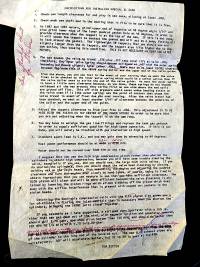REF: Engine Mechanicals - Sub-01M
Notes on Sifton Cams by Tom Sifton
Instructions for Installing Special XL Cams 
 (Posted by Staffords on the XLForum)
(Posted by Staffords on the XLForum)
1. Check cam length clearance for end play in cam case, allowing at least .005.
2. Check each cam shaft end in the bearing that it fits to be sure it is free.
3. On 1957 and 1958 motors, grind upper end of tappetts at 45 degree angle 1/16“ and also grind lower edge of the lower pushrod gasket hole at 45 degrees, in order to provide clearance when the tappett is at the top of the cam. If this is not done, it will cause the tappett to contact the gasket and will act as a pump, forcing oil to leak around the gasket. The lightweight KR tappetts that you should use are slightly longer than the XL tappett, and the tappett also lifts higher due to the cam action, thus causing this condition. THIS IS NOT NECESSARY ON 1959 AND LATER MOTORS.
4. (updated) For XL STROKER INTAKE AND EXHAUST CAMS - Both inlet and exhaust cam lobes move the valve .436. See that there is 1/2” clearance between the uppoer end of the valve guide and the underside of the valve spring collar when the valve is on the seat. Check this with both valve springs and with the collar and keepers assembled. If there is less than 1/2“, then grind off the upper end of the valve guide. Then assemble with inner spring only in place, shim or grind so that spring will become boilbound (fully compressed) at .450 to .455 of the valve travel. Then remove inner spring and install outer spring. Shim or grind so that spring is coilbound at .465 to .470 of valve travel.
From the above, you can see tha in the event of over revving that we want the valve float to be checked by the inner valve spring which would be a sfter action than if the valve collar were to strike the end of the valve guide. We want the outer spring to have a little more clearance because, as you know, these springs do not become coilbound all the way around; they strike first on the one side where the end coils are ground off flat. This off side pressure would cause undue bending strain on the valve stem if it (the outer spring) was the point of contact that stops the valve travel in event of float due to over revving. After the valve travel has been checked, we want at least another 1/16” of clearance between the underside of the collar and the upper end of the guide.
5. Adjust the tappett clearance to from just free to .002. This adjustment IS TO BE MADE WITH THE PISTON ON TOP DEAD CENTER OF THE POWER STROKE in order to be sure that you are not adjusting when the tappett is on the cam ramp.
6. You may have to enlarge the gas line fittings and replace the tank gas petcock in order to supply sufficient gasoline for high speed operation. If this is not done, you will surely be troubled with gas starvation at high speed.
7. Standard spark lead is O.K., and you may gain some by advancing to 48 degrees.
Best performance should be at 6300 to 6400 RPM.
Motor should not be revved over 7000 RPM at any time.
For all out best results, you should use straight pipes measuring 37“ from the edge of the cylinder to the long end of the beveled cut. The new XLCH exhaust pipes are satisfactory. 40” will accelerate better, but 37 to 38 is best at top RPM.
TOM SIFTON
The following text was scribbled over (after Item# 7):
I suggest that you use the XLCH high compression piston rather than shorten the cylinders to obtain high compression, because you will have some trouble clearing the valve, especially if you use, and you should use, the large XLCH inlet valves. If you do shorten the cylinders, then you should check the valve head clearance by placing molding wax on the valve heads, then assembling the engine and adjusting the pushrod clearance and turn the engine over slowy by hand (cams, of course, being in time) to obtain impressions that you can measure to see that you have sufficient clearance. The XLCH piston will clear and will be more efficient because the valve clearance is obtained by lowering the piston rings which allows slabbing off the piston which does away with the airflow interference that is present with cupped out pockets in the piston heads.
Obtaining the desirable compression ratio with the XLCH piston also saves you a lot of trouble in fitting the inlet manifold that is necessary when you shorten the cylinders, bringing the inlet ports closer together.
If you assemble as I have suggested, a stripped down Sportster with a 150 lb. rider that can get down out of the wind, with magneto ignition and generator removed, should pull 3.70 gear, and should run better than 130 MPH, and should do better than 105 MPH in the 1/4 mile with 4.70 to 4.80 gear.
The following was the original text of Item #4: (scribbled over)
The cam causes the valve to travel .375 plus .017 ramp total lift at valve .392; therefore, the inner valve spring should become coilbound at .407 with the outer spring becoming coilbound slightly later (about .422). There must be at least 15/32“ clearance between the underside of the valve spring collar and the upper end of the valve guide.
